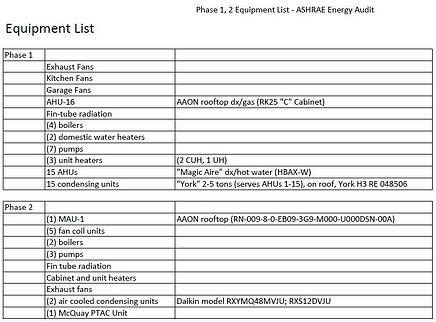In a recent blog post, “The Benefits of an ASHRAE Level 1 Energy Audit,” I discussed the process of performing an ASHRAE Level 1 energy audit, which is the first step in the LEED accreditation process for Existing Buildings (LEED EB). The Level 1 report is used to determine whether there is enough energy saving opportunities to proceed with LEED EB accreditation. In order to receive an energy credit in the official LEED EB application, however, an ASHRAE Level 2 energy audit is required. The Level 2 audit uses energy surveying and an engineering analysis to provide an even more detailed breakdown of how a building is performing; going deeper into the analysis of the Level 1 measures and identifying additional measures to improve the efficiency and functionality of the building. The Level 2 report details the opportunities to such a degree that actual decisions on implementation can be made and the LEED EB credit can be realized.
ASHRAE Level 2 Energy Audit Process
The Level 2 process is designed to follow the Level 1 audit. The following list is a brief description of the steps performed for the Level 2 audit:
- Review design and installation for mechanical and electrical systems as well as maintenance and operating methods.
- Describe/analyze all energy using systems (i.e. envelope, lighting, HVAC, etc.), based on site visits, measurements and calculations.
- Review existing operation and maintenance (O&M) issues (this was a step for the Level 1 audit as well, so there may not be new information gathered here).
- Review and measure operating parameters, then compare these values to the original design intent.
- For example, supply air temperature from an air handler as well as the linked space temperature and humidity level. Is this air handler performing as intended and can it meet space requirements? This step generally requires energy metering devices, which will log data such as power or light intensity. It will allow the auditors to accurately monitor temperature, energy usage and how often the equipment is running. The meter plan will be affected by which equipment has potential for energy savings. It does not make sense to meter every piece of equipment if there is no way to change how it is used.
Using the total annual energy use, determine the breakdown of each end use for the particular building. The image below shows what this can look like.
 Source: "California Statewide Commercial Sector Energy Efficiency Potential Study," California Energy Commission, July 9, 2002, Study ID #SW039A, Final Report, Volume 1 of 2.
Source: "California Statewide Commercial Sector Energy Efficiency Potential Study," California Energy Commission, July 9, 2002, Study ID #SW039A, Final Report, Volume 1 of 2.Using information from the above steps:
- Create a list of all possible changes that can be made to the equipment and operations that could potentially save energy. After creating a list, prioritize which ones are practical to implement and perform a preliminary cost and savings estimate of these measures. Impractical measures should still be listed in the report, with an explanation as to why it was rejected.
- Determine the estimated costs for all practical measures, as well as the associated savings and an indication of whether it is economically practical (i.e. is the simple payback period reasonable?). This work coincides with the Level 1 audit, but the results of the Level 2 audit are more in depth due to a deeper level of analysis. For each practical measure, the Level 2 report requires a large amount of information such as expected life of new equipment, outline of new skills required for operating staff, all energy and cost calculations performed, and any non-energy benefits (comfort, safety, equipment runtime, etc.). The Level 2 audit requires much more work from the auditor to achieve the expected energy savings.
Next Steps
Prior to the first site visit for the Level 2 audit, it is important to have a good handle on what was observed and suggested for the Level 1 audit. The measures identified will be looked at in more detail, and additional measures will be found based on the greater scale of review in regards to design documents, system installation and system functionality.
The Level 2 audit emphasizes the importance of working with the building owner/operator to discuss what is truly feasible for them to accomplish. Although many suggestions can be made to improve a building, the measures that can actually be implemented are the ones that will make the building perform better.



